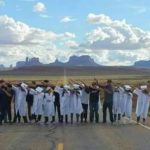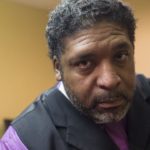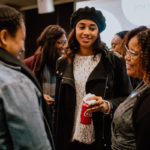By Zenobia Jeffries
Yes! Magazine, Mar 10, 2017 —
The social justice implications of spitting into a test tube.
As a descendant of enslaved Africans, I’ve always wondered where on the massive continent does my family have its roots. As I aged, I became more uneasy with the phrase “descendant of enslaved Africans.” Where in Africa and from whom, specifically? Millions of people from several different regions were brought to this land.
More than 20 years ago, my mother and aunt started a process of finding these answers. My mother then was excited to tell me about a man named Cupid, a not-so-distant relative.
The Rev. Cupid Aleyus Whitfield was born in 1868 to Cato and Amanda Whitfield, former slaves of Gen. William Gilchrist of Gadsden County, Florida. When he was about 16 years old, Cupid began teaching at a primary school and became known as one of the leading “colored” teachers in Gadsden County. He married Rebecca Zellene Goodson in 1889, and they had either nine or 14 children, depending on the source consulted.
My mother and aunt learned their father, Charlie Whitfield—my grandfather—was one of Cupid’s grandsons. This is all that I know of my maternal grandfather’s lineage. Of my maternal grandmother’s, I know even less.
Of my paternal family, I knew only my father’s name, and even after I met him in the late 1980s, that was still all that I knew. I never met his mother, father, or his siblings, and did not know their names. He passed away in April 2006, and I didn’t learn about his death until months later. But I still wanted to know more about him. And so I began my search.

YES! Illustration by Bobby Sims.
This new technology is revolutionary for folks like me.
Unlike my mother and aunt’s experience of uncovering information to fill in the many blanks in our family tree, I have the privilege of Google, ancestry websites, and DNA testing companies that emerged in the early 2000s. This new technology is revolutionary for folks like me, who want to know not only where they come from but also from whom—genealogical researchers, adoptees searching for family members, and folks tracing family trees, particularly African American families that had been displaced by slavery.
In her decade-long fieldwork to learn how the new technology impacts the way people self-identify, Alondra Nelson, Columbia University professor of sociology, says she found so much more. Her latest book, The Social Life of DNA: Race, Reparations, and Reconciliation After the Genome, explores the way in which DNA is being used as a tool for racial reconciliation.
Beacon Press
I spoke with Nelson about what DNA science might offer social change.
Zenobia Jeffries: You open your book with the story of the Grandmothers of the Plaza de Mayo, the human rights organization that helps find children who were stolen and illegally adopted after their mothers were killed during the Argentine Dirty War. You later tell how DNA was unsuccessfully used in a reparations case here in the United States. How can science help answer fundamental questions about social justice and equality?
Alondra Nelson: The Argentina story shows us that science can help. In that case you’re talking about grandparents and grandchildren. When you’re doing a match, that sort of genetic line is actually pretty close. When you’re talking about the experience of people of African descent, there’s a gap of hundreds of years; you have a bigger mystery and a technical hurdle because you’re dealing with the history of the slave trade. In post-apartheid Africa, you have families who have not been able to do burial rites for members of their [families] who died in the apartheid struggle. I think to be able to identify the remains of a specific loved one, and to be able to commemorate, bury, and memorialize that person is really powerful. Science can help with that identification, but we need to have some complicated conversations. Science can’t be our moral compass.
Jeffries: What implication does DNA testing have for understanding racial and ethnic identity?
Nelson: It’s complicated. The tests are far from definitive. The companies use different databases and make different kinds of mathematical and statistical assumptions. Those formulas and algorithms are their trade secrets, so they’re under no obligation to share them with other countries. So, what we think about in an academic setting, when you think about something being scientifically valid, it means that you can replicate it, you can verify it; [if] someone else does the same experiment or uses the same genetic sample from you and puts it in their database, they’ll get the same results. With these companies, we don’t have any of those kind of gold standards of what we might consider academic research science.
That said, for communities like African Americans, they are in many cases left without any other way to think about that. Though we have some communities who’ve been able to use food and linguistic ties, like the Gullah/Geechee communities, who link to contemporary Sierra Leone through linguistic ties. But those cases are less common.
And so you have a large swath of people who want to know and who are willing to try different ways of knowing. It can help to the extent that, regardless of whether you’re of African descent, you’ve seen the reality television shows—people get a test, and it gives them sometimes new information, sometimes surprising information, or sometimes it just confirms or underscores what they already thought they knew.
Jeffries: Some tests break down one’s percentage of ethnicity. But does knowing that bring us closer or divide us further when you talk about the struggle toward racial justice?
Nelson: A test that says you’re this percent of this or this percent of that is making not a historical or factual assumption; it’s making a statistical and probabilistic assumption. So, what does it mean if a test says you’re either 100 percent or 30 percent Nigerian? That means they’ve created some algorithm that they assume is 100 percent Nigerian. But what in the world would that be? The history of human history is one of intermixing, intermarriage, intermating.
I use the phrase “genealogical aspirations” because the questions that people have in agreeing to the testing experience sort of shape what it can mean for them. If it’s important for you to know what part Norwegian you are versus what part Russian, then you’re going to be interested in how you slice those things up. But if you’re more interested in whether you’re more European or more bio-geographically mixed, then you have a different read of what the tests are.
For me, what’s important is not so much that these types of tests give you the truth of who you are, your identity, but that they suggest how we have come to think about putting human beings in buckets. None of these categories means anything outside of culture and history.
For people of African descent it becomes very empowering.
Jeffries: You say DNA can be used as a tool in the struggle for racial justice. Is using it for genealogical research part of that struggle?
Nelson: Sure. For people of African descent who feel incomplete without having that information about their African ancestry, it becomes very empowering.
Whether we’re talking about genetics or identity, we know that social movements and social activism come out of a sense of empowerment and agency. And like-minded people who feel empowered and outraged about the way things are can change things. That empowerment comes to some through the use of these tests is part of what mobilizes them for social justice issues.
Jeffries: For the companies that own these databases, is there something to be said about the politics of privacy and the ethics of who keeps our DNA?
Nelson: Different companies do different things. Often the consent forms you sign when you do one of these tests look like the consent that you sign when you’re uploading a new operating system—there’s a lot of small words and people don’t really read it. We know, for example, that some companies keep all of your data, because when you’re dealing with millions of genetic markers, the bigger your databases are, the more reliable statistically speaking your findings can be.
And now that some companies are interested, not only in genetic ancestry testing but also in pharmaceutical developments, this data becomes really important. They’re using people’s genetic samples to try to do investigations and for the development of personalized medicine and protocols.
But then you have the new genetic genealogy 2.0 that’s been happening: the ability for people to upload their markers online, to make them available to other geneticists.
On one website you can fill out as much as you can of your family tree and also upload your genetic genealogy results so that other people can see them or people can contact you. On the one hand, there’s two different competing interests here: One is people wanting to know more about their genealogy and their genetic genealogy, which might cause them to reveal information to other people. But then there’s also this real necessary interest in privacy and the desire for privacy.
Someone might think, “Well, I’m just using this to do my genealogy.” But that same data could be used to reveal things about your medical profile or could be used potentially to implicate people in the criminal justice system.
The thing about DNA that’s different from other kinds of data is that it can be useful in all of these different social and political sites—the exact same data, the exact same samples, potentially. That’s where the portability and transitive nature of DNA technology is the concern.
I’m not trying to paint a dystopic future, but I think it’s something to worry about. Genetic data carries a lot of information that can be used simultaneously in a lot of different places for purposes for which people intend it to be used, and purposes that they do not.
Zenobia Jeffries wrote this article for Why Science Can’t Be Silent, the Spring 2017 issue of YES! Magazine. Zenobia is the racial justice associate editor. Follow her on Twitter @ZenobiaJeffries.












